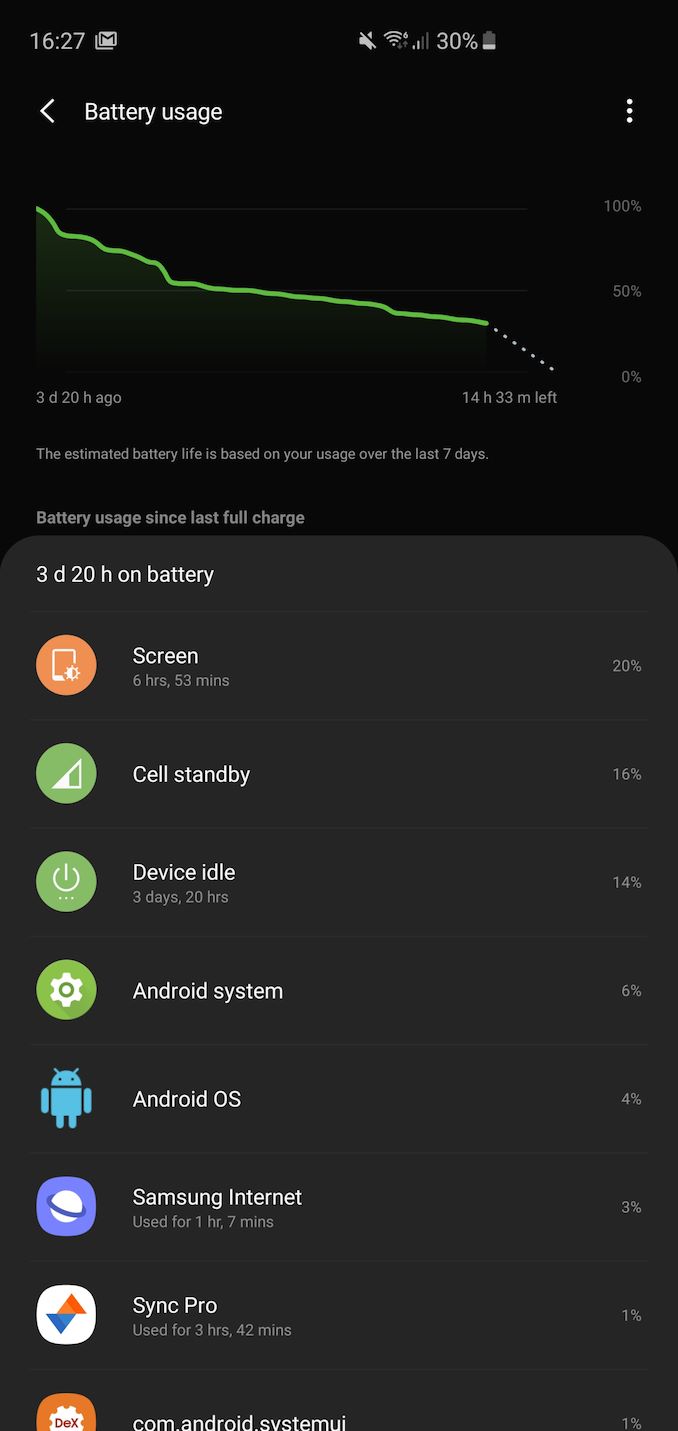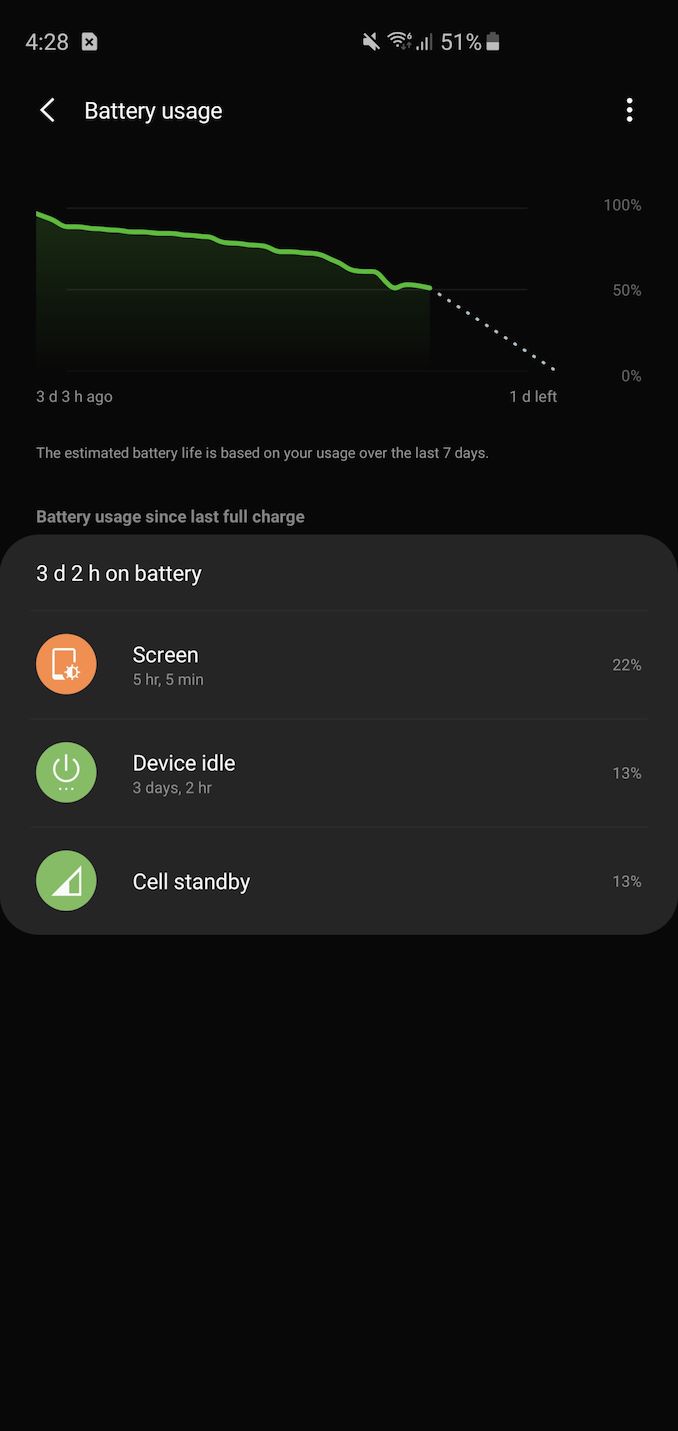The Samsung Galaxy S10+ Snapdragon & Exynos Review: Almost Perfect, Yet So Flawed
by Andrei Frumusanu on March 29, 2019 9:00 AM ESTBattery Life: Impressive
Battery performance of the Galaxy S10+ has been touted to be as class-leading. The introduction of a larger battery, more efficient screen as well as a new generation of SoCs are sure to bring improvements over last year’s Galaxy S9. One aspect that readers will have waited for impatiently is our testing of the new Exynos 9820 variant against the Snapdragon 855, which has also been one topic I’ve been extremely interested to see.
We run Samsung's Galaxy devices at the full potential they can deliver, something we've done for several generations now. This means that the screen resolution is set to the native 1440p of the display panels, and the new battery settings on the S10 were also set to "Performance" mode.
Without further ado, let’s get do the results:

In our web browsing test, both Galaxy S10+s are showcasing outstanding longevity at 13.08h for the Exynos and 12.75h for the Snapdragon variant. Least to say, I was extremely surprised to see this result even though we measured the Exynos 9820 CPU to be quite less efficient than the Snapdragon 855 in peak performance efficiency. I would have not expected the Exynos to match the Snapdragon, much less slightly beat it.
Before going into more details, let’s see the PCMark battery test results:

Here, in absolute terms, the Galaxy S10+ aren’t quite as impressive as on the web test and further lag behind the excellent results of the Kirin 980 devices. Nevertheless, these are some impressive figures and again it’s very good to see that both units are almost evenly matched, this time the Snapdragon unit lasting slightly longer than the Exynos.
To explain these results, we have to keep one thing in mind: the Exynos unit will have posted worse performance than the Snapdragon, so it will have spent more time at the lower more efficient frequency states.
One thing that I also noticed, is that in very low idle loads where there’s just some light activity on the A55 cores, the Exynos 9820 variant actually uses less power than the Snapdragon unit. The figures we’re talking about here are 20-30mW, but could possibly grow to bigger values at slightly more moderate loads. It’s possible that Qualcomm has more static leakage to deal with on the 7nm process than Samsung on 8nm, one thing that I’ve come to hear about the TSMC 7nm node.
Furthermore, one of the biggest improvements for the Galaxy S10 over past devices isn’t actually the SoC nor the actual bigger battery. It’s actually the display as well as the base power consumption of the phone. In Airplane mode, the base power has gone down by almost 100mW compared to the Galaxy S9+ which is a fantastic development and is especially something that will result in higher low-brightness battery life.
Currently in my time with both S10+ units, I can say they’ve been among the longest lasting Android devices I’ve tested.


Exynos vs Snapdragon in identical usage patterns & Prolonged idle periods
One issue I can confirm with the Exynos unit is that after a voice call in any app, the phone isn’t correctly entering its lower power state, and will suffer from increased idle battery drain until a reboot. This is something that hopefully Samsung addresses in a firmware update as it doesn’t look to be a hardware related issue. When not affected by this bug, both phones idle very similar to each other and slightly better than the S9+ I use as my daily device.










229 Comments
View All Comments
Azurael - Saturday, March 30, 2019 - link
"the M4 cores should very much be quite a lot more efficiency than the A75 cores"*brain explodes*
Samus - Sunday, March 31, 2019 - link
They should have gone with a pop-out camera than the hole punch. Hate to say it but apples notch was the best solution other than a pop-up camera.Javert89 - Sunday, March 31, 2019 - link
Just a precisation. Adreno 640 do not have 50% more execution units, indeed it should be the usual 2 core design seen in the 630.. only the Adreno of the bigger Snapdragon 8cx has 3 cores plus a 128 bit memory controllerAndrei Frumusanu - Sunday, March 31, 2019 - link
It *does* have 50% more execution units / ALUs; https://images.anandtech.com/doci/13680/Screenshot...bjtags - Sunday, March 31, 2019 - link
Huawei Mate SE 99% of this for 1/4 the Price.....s.yu - Monday, April 1, 2019 - link
Entirely laughable.tipoo - Sunday, March 31, 2019 - link
The efficiency + performance of the A12 even in comparison to this continues to be crazy, and we're on the other side of the year of that launching.I'd be really interested to see that put against x86 cores in SPEC2006
name99 - Monday, April 1, 2019 - link
Here you are. Not a PERFECT comparison but the best currently available:https://www.anandtech.com/show/13392/the-iphone-xs...
https://www.anandtech.com/show/11544/intel-skylake...
Would be great if we had comparison graphs, and if it were compiler to compiler (both LLVM) and if it were desktop cores, and if it were Coffee Lake, and ...
But as I said it's the best available right now.
Basically (especially if Apple adds SVE to their desktop ARM core) they probably have nothing to fear in terms of reduced performance by switching to the A12 successor.
s.yu - Monday, April 1, 2019 - link
I gotta say I'm surprised from the first sample that the S9+ was the best among the Samsung's and very, very close to Pixel performance which is still overall No.1, S10PS only comes second, S10PE is about as bad as the Note9, I think some of these have defective lenses with especially bad resolution on the edge(s)...the difference is much smaller in the center of the frame. So it could be said that even with the f/2.4 aperture, the Samsung's lens has QC issues that aren't masked. It would be interesting to see how P30P's f/1.6 lens fares.S9+ didn't stand out so much in the HDR scenes though, but from the landscapes I'd say the S9+ probably got an especially good lens sample, better than the S10PS and much better than the S10PE. How the Pixel reproduces texture is just incredible, though many of the scenes are rendered darker, there's little sign of the crushed black issue, i.e. it's just darker, but high quality, it's still my definition of realistic among almost any smartphone output, it would obviously stand better to sharpening or NR in post.
Regarding the wide shots...HDR's the differential. The S10PS outperformed the Mate20P despite a wider FoV in most of the landscape samples, but failed to do so in the shot under the bridge.
IMO in low light shots the PS still wins overall, to the PE, PE seems to have issues mapping black (with minimal actual shadow advantage) while in the midtones as both win in certain instances it's a toss. Still nothing beats the Pixel...Mate20P's auto was especially bad in the maintenance center shot, that was interesting considering the sensor size.
And I have to disagree just from the first night sample that the PS isn't matching Mate20P's night mode, it's evident that it did a poor job on the sand, but *everything else* on the frame is better, the subject, the houses in the background, the light posts. It is clear in the second night mode shot with a low DR range though, that the Samsung's messed up.
lty0432 - Monday, April 1, 2019 - link
Hi author !I think this kind of technical articles on Exynos and SD has been best out there.
Can I possible get your opinion on how mobile processors stack up against PC processors ?
Are there any benchmark comparison articles ?